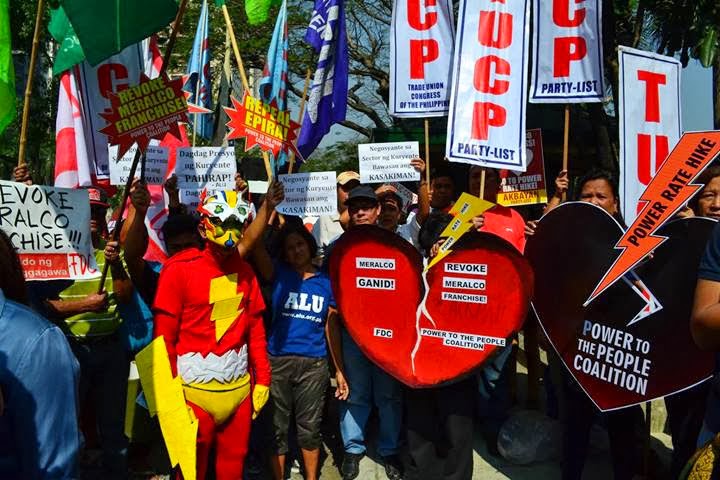 |
| President Aquino is greeted by European Council President Herman Van Rompuy |
MANILA, Philippines - President Aquino has formally asked Congress for emergency powers that would enable him to address the projected electricity shortage next year.
Aquino made the request in a letter to Speaker Feliciano Belmonte Jr., a copy of which was furnished Senate President Franklin Drilon.
However, Drilon said it was impossible for the Senate to come up with the joint resolution by the end of September since Congress has only four plenary sessions left before it adjourns for a three-week break.
“We don’t even have the draft joint resolution. We don’t know the parameters of the authority being requested. We know the urgency, but we can’t rush into this,” he said.
The letter-request, dated Sept. 12, was included in the House order of business yesterday and sent to the rules committee chaired by Majority Leader Neptali Gonzales II.
“In accordance with Section 71 of Republic Act 9136, otherwise known as the Electric Power Industry Reform Act of 2001, I hereby seek the immediate enactment of a joint resolution authorizing the President to establish additional generating capacity,” Aquino said in his request.
He informed Belmonte and Drilon that the Department of Energy predicts a “critical electricity situation” in the summer of 2015 due to, among other factors, the expected effects of the El Niño phenomenon and delays in the start of operation of “committed power projects.”
“There is no gainsaying that the imminent electric power shortage during these months is a real threat to the country’s growing economy and the general welfare of the people.
“The speedy enactment of the joint resolution will ensure the energy requirements of the country for this critical period – through a specific, focused and targeted acquisition of additional generating capacities for use during the limited periods of time of very tight energy supply,” the President said.
“This authority is needed in order to address the imminent shortage of electric power for the summer of 2015 in Luzon. I look forward to a favorable response from both houses (of Congress),” he added.
Gonzales said they are reviewing the draft bill before referring it to the committee on energy. “We will attend to the President’s request with dispatch,” he said.
Cannot be rushed
Drilon said the Senate would work on the measure “as fast as we can,” but could not be rushed to approve it.
“I think the committee on energy chaired by Senator (Sergio) Osmeña will meet on Wednesday next week. Given all the complicated issues, we cannot rush into this but we know the urgency. We will work on this,” he said.
During the hearing on the proposed 2015 budget of the DOE yesterday, Drilon said the President’s letter was too “broad” and did not contain the parameters for the authority being requested from Congress.
Osmeña also echoed Drilon’s statement that the authority could not be granted to the President by the end of the month.
“I’ve been telling them we’ll have a shortage since 2011 and then now this is going to be my fault? It’s not accurate for them to depend on Senate approval before the end of September,” he said.
He said the Senate has a duty to protect the people from the possible adverse impacts of the grant of emergency powers to the President.
He cited the experience during the Ramos administration when several independent power producers were contracted to address the power crisis with a take or pay guarantee. This led to an overcapacity and the National Power Corp. accumulating a massive debt.
Cost to taxpayers
Sen. Francis Escudero said he wants to find out how much the government would incur and its cost to taxpayers.
“What’s the cost to taxpayers of this measure? Even if power contracted by the government will eventually be sold to distributors, and thus the acquisition cost will be recouped, we still would like to know the costs involved,” said Escudero, chairman of the Senate finance committee.
“How will it be financed? Even if it’s an off-budget transaction, the government has the duty to publicly disclose the details,” he added.
Only solution
Energy Secretary Carlos Jericho Petilla said he had raised the issue since July and would continue to push for the establishment of additional generation capacity as “the only solution… at this point.”
While there are other solutions for the expected power shortage next summer, he said there are no guarantees that these would materialize, and might even be more expensive.
Among the options is the Interruptible Load Program (ILP), which involves distribution utilities such as the Manila Electric Co. and electric cooperatives asking their big load customers to address their power requirements by using their own generator sets.
Petilla said private sector response to the ILP has been “dismal” and there is no guarantee it would materialize and address the power shortage.
He said the old Malaya geothermal power plant in Rizal, also among the options, has to be rehabilitated to be utilized.
Given the uncertainties with the other options, Petilla said contracting with power suppliers is presently the only real solution.
Suppliers’ requirement
He said the end-September deadline for the contracting of additional power was based on the requirement of the suppliers of a six-month period to be able to guarantee the necessary load.
“It’s absolute as far as the supplier is concerned,” he said.
With Congress saying that it cannot come out with the joint resolution this month, Petilla said he could settle for a supplier who could provide power requirements of the country in three months.
“But it will be expensive… I don’t think there is anybody who can supply in three months,” he said.
“There are alternatives but the question is, are we willing to pay for it. There are many alternatives, but our problem is time and cost constraints. What we have to consider is if we’re willing to have brownouts. It all depends on what we want,” he added.
Go slow
Militant party-list representatives and other members of the House minority bloc, however, cautioned Congress to go slow in the grant of emergency powers to avoid the anomalies that took place during the Ramos administration.
“We should not commit those mistakes again, like entering into a take-or-pay arrangement, which allows an investor to be fully paid for his generating capacity, whether that is used or not. We should pity the consumer, who will ultimately pay for our mistakes,” Isabela Rep. Rodolfo Albano III, a member of the minority, said.
He said Congress should impose strict parameters for the exercise of emergency powers.
He said Petilla should tell lawmakers his agency’s plans to increase generating capacity in Luzon for the middle of next year.
“Are they buying generators or are they renting? What do they exactly want to do? What are the details? Secretary Petilla should tell us because he will be the one who will be in charge of implementation. As of now, we are groping in the dark, we are guessing. ” he said.
Albano said Petilla should also verify his department’s data on “generating capacity, dependable capacity and demand” to clear up confusion.
“If his own figures for 2013 were to be believed, we even have excess electricity available in Luzon,” he said.
He cited the figures released by his minority colleague, Bayan Muna Rep. Neri Colmenares, and supplied by the DOE, that installed capacity for the Luzon grid is 12,790 megawatts, while dependable capacity is 11,469 MW.
The peak demand for the grid is just 8,700 MW, with Meralco using 6,121 MW.
“If these figures are correct, we will have enough electricity in Luzon next year, when a shortage is projected. Unless they are wrong,” Albano said.
TUCP backs bill
The Trade Union Congress of the Philippines (TUCP) expressed support for the grant of emergency powers for the President, but said he must also ensure that it will not lead to power rate hikes.
“We insist that the Department of Energy now present their tariff simulations and cost-impact scenarios to the public so we will know what to do,” TUCP executive director Luis Corral said.
The TUCP said the DOE’s proposals, such as gas turbines and diesel-powered generation sets, could lead to higher power rates.
“We have already advised DOE to do tariff simulations first because the power crisis cannot just be defined as a lack of power supply, it is also about uncompetitive power rates,” the DOE said in a statement.
“It is the consumers who are being punished for the failure to inspect defective meters in 125 distribution utilities by the ERC. And now the power industry wants to add to their profit by creating a power shortage which will allow them to charge more,” the TUCP statement added.
Doable plans
Militant labor group Partido ng Manggagawa (PM) called on Congress to ask the President to present doable plans to solve the looming power crisis before granting him emergency powers.
PM spokesman Wilson Fortaleza warned that palliative solutions to the power crisis would only bring more problems.
He said the Aquino government should be blamed for the power crisis for doing nothing since warnings were raised as early as 2010.
Fortaleza said lawmakers should also declare the EPIRA and privatization a failure and audit all the plants’ capacities before granting emergency powers to the President. –
By Jess Diaz (The Philippine Star) With Mayen Jaymalin, Marvin Sy, Artemio Dumlao




